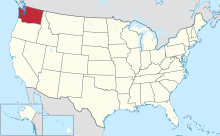 Map of the United States with Washington highlighted | |
| Number of elections | 33 |
|---|---|
| Voted Democratic | 18 |
| Voted Republican | 14 |
| Voted other | 1[a] |
| Voted for winning candidate | 23 |
| Voted for losing candidate | 10 |
Washington is a state in the Pacific Northwest region of the United States. Since its admission to the Union in November 1889, the state has participated in 33 United States presidential elections.[1] It has had twelve electoral votes since 2012, when it gained a tenth congressional district during reappropriation based on the results of the 2010 U.S. census.[2][3] Washington has conducted its presidential elections through mail-in voting since 2012 for general elections and 2016 for party primaries.[4]
In the 1892 presidential election, incumbent president Benjamin Harrison received 41.45% of the popular vote in Washington and obtained the state's four electoral votes in his unsuccessful re-election campaign.[5] Washington generally favored the Republican Party in presidential elections until 1932, reflecting its state and congressional voting patterns.[6] The state was won by Progressive Party presidential nominee Theodore Roosevelt in the 1912 election; Roosevelt, who had been a Republican during his presidency, remains the most only third party candidate to have won Washington's presidential election.[6][7]
From 1932 to 1948, Democratic candidates won Washington in landslide victories for the presidency and state offices as a result of the Great Depression and New Deal.[6][8] Washington was characterized as a swing state for the remainder of the 20th century and voted 21 times for the winning candidate from 1892 to 1996.[6][7] Since 1984, no Republican candidate has won a presidential election in Washington.[9] In 2009, American journalist Ron Brownstein referred to Washington and 17 other states collectively as the "blue wall" due to its strong preference for Democrats.[10][11]
Washington is typically thought of as politically divided by the Cascade Mountains, with Western Washington generally being liberal and Eastern Washington generally being conservative.[12] However, due to Democratic dominance in the Seattle metropolitan area, which has the majority of the state's population, Washington is generally labeled as a blue state.[13][14] The state adopted a single-ballot blanket primary system in 1936 to replace earlier party primaries; until 2020, these were non-binding and not used to determine delegates in national party conventions.[15][16]
Washington state has signed the National Popular Vote Interstate Compact, an interstate compact in which signatories award all of their electoral votes to the winner of the federal-level popular vote in a presidential election, even if there are other candidate won some of individual signatorys' popular vote. However, it has not yet gone into force as of 2023.[17]
Cite error: There are <ref group=lower-alpha> tags or {{efn}} templates on this page, but the references will not show without a {{reflist|group=lower-alpha}} template or {{notelist}} template (see the help page).
- ^ Oldham, Kit (March 1, 2022). "Washington is admitted as the 42nd state to the United States of America on November 11, 1889". HistoryLink. Retrieved June 21, 2023.
- ^ "Road to the White House" (PDF). Secretary of State of Washington. Retrieved August 19, 2024.
- ^ "Washington one of few Dem-leaning states to gain congressional seat". The Seattle Times. December 21, 2010. Retrieved August 19, 2024.
- ^ Gutman, David (April 7, 2019). "Washington Democrats choose presidential primary for 2020, ditching precinct caucuses". The Seattle Times. Retrieved August 19, 2024.
- ^ Guide to U.S. Elections 2010, p. 773.
- ^ a b c d Bone, Hugh A. (1985). Political Life in Washington: Governing the Evergreen State. Pullman, Washington: Washington State University Press. pp. 8–9. ISBN 0-87422-018-1.
- ^ a b Postman, David (November 12, 2000). "Strong Gore vote hints Washington no longer has swing-state status". The Seattle Times. p. A1. Retrieved August 19, 2024.
- ^ Phillips, Kevin (2015). The Emerging Republican Majority (STU - Student ed.). Princeton University Press. p. 485. ISBN 978-0-691-16324-6. JSTOR j.ctt9qh063. Retrieved June 22, 2023.
- ^ Balk, Gene (May 17, 2021). "'Most important election of our lifetime' brought record voter turnout in Washington". The Seattle Times. Retrieved August 19, 2024.
- ^ Brownstein, Ron (November 2, 2016). "Clinton's Campaign Is Focused on Battleground States She Doesn't Really Need". The Atlantic. Retrieved August 19, 2024.
- ^ Steinhauser, Paul (November 12, 2012). "Holding Democratic 'blue wall' was crucial for Obama victory". CNN. Retrieved June 21, 2023.
- ^ Carlsen, Audrey (September 1, 2016). "Red state, blue state: Watch 40 years of political change in Washington". The Seattle Times. Retrieved June 27, 2023.
- ^ Brown, Justin (December 8, 2022). "Exploring Washington State's East-West Divide". Battleground. Retrieved June 21, 2023.
- ^ Webley, Kayla (January 15, 2013). "A State Divided: As Washington Becomes More Liberal, Republicans Push Back". Time.
- ^ Clayton, Cornell W.; Donovan, Todd; Lovrich, Nicholas P., eds. (2018). Governing the Evergreen State: Political Life in Washington. Pullman, Washington: Washington State University Press. pp. 46–47, 54. ISBN 978-0-87422-355-2. OCLC 1015824451.
- ^ Gutman, David (April 7, 2019). "Washington Democrats choose presidential primary for 2020, ditching precinct caucuses". The Seattle Times. Retrieved August 26, 2024.
- ^ "Status of National Popular Vote Bill in Each State". National Popular Vote Inc. November 11, 2016. Retrieved June 21, 2023.